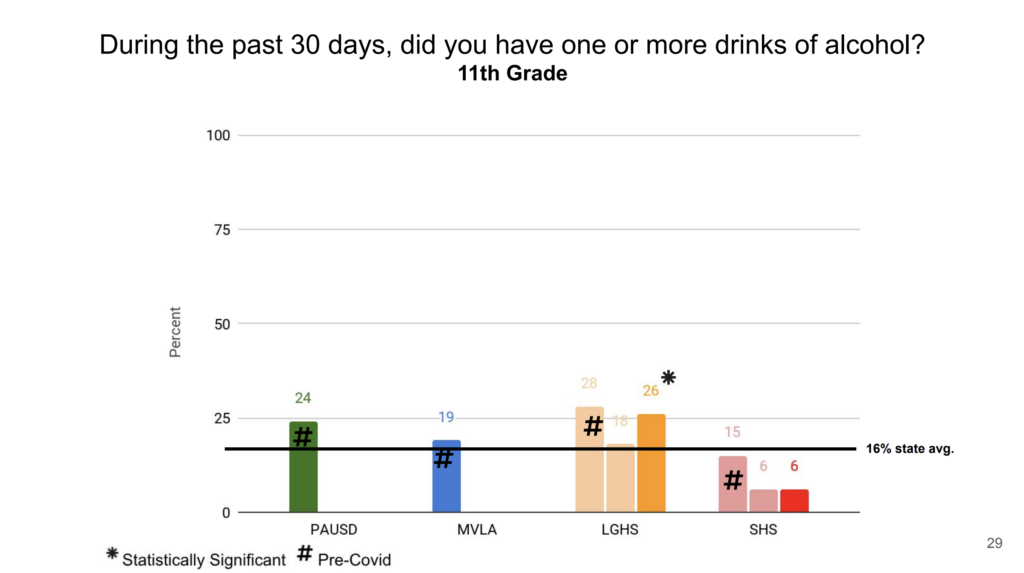In 2023, 17% of high schoolers nationwide are addicted to drugs, more than two thirds of high schoolers have tried alcohol illegally and 12% of high school students have said they have vaped in the past month, according to American Addiction Centers and the National Library of Medicine.
These numbers are alarming to observers, and, more specifically, usage trends appear to be going in the wrong direction after the pandemic. Pre-pandemic in 2018, nicotine use surges related to vaping were the largest recorded in 43 years, with an additional 1.3 million nicotine vapers than in 2017.
According to a national survey conducted by the New England Journal of Medicine, the percentage of 12th-graders vaping doubled between 2017 and 2019, from 18.8% to 35.1%.
Going into the pandemic, 20% of all high school students reported vaping in a survey done by the Center for Disease Control and Prevention. Though the survey data showed a 40% decline in these rates in 2021, data validity has been called into question due to inconsistent surveying methods. For example, while the National Youth Tobacco Survey was historically conducted at school, but was completed at home during the pandemic. For this reason, the survey methodologies were adjusted.
Assistant principal Matt Torrens said he saw the growth of the vaping first hand.
“Before the pandemic, there were a lot of vaping materials that we would find in the parking lots and all over campus,” assistant principal Matt Torrens said. “After the pandemic, it has gone down; I’m not sure if the behaviors have changed necessarily, but it’s being done less on campus.”
The administration mainly relies on teachers and other staff members to report these instances of usage, whether they find evidence of a student vaping or drinking or simply suspect it to be the case.
Despite the apparent decline of vaping on campus, Torrens said other forms of substance abuse are still present, and the administration is taking many steps to raise awareness surrounding the dangers of these issues. Drinking was especially present among students before the pandemic and persisted after quarantine ended, he said.
“Apathy of peers is what often leads to substance abuse; kids make good and bad choices, mostly based on what their peers say,” Torrens said. “If kids can learn to speak up and voice their opinions so that their friends make good decisions, we would be much better off.”
California Healthy Kids Survey: signs of increased drug usage at some schools
To track students’ behaviors and attitudes over time the district has used data from the California Healthy Kids Survey (CHKS) for many years now.
The CHKS was most recently conducted last spring during a MOSAIC. Students filled out the survey anonymously and were asked about a wide range of topics from school engagement and safety to alcohol, vaping and drug use. The district also asked staff and parents or guardians to complete the survey.
The student survey included these results:
- Six % of freshmen reported vaping e-cigarettes pre-COVID, but no freshmen reported vaping in the most recent survey.
- In the past month, 17 % of seniors said they had used alcohol; 11 % reported using marijuana; and 6 percent had vaped.
- Seven % of seniors said they had been drunk or high at school at least once.
- Eight % of seniors said they were currently vaping
- Ten % of seniors described themselves as binge drinkers.
Experts worry that the downward usage following the pandemic may not hold for long. The pandemic disrupted teens’ access to these substances and peer groups that encouraged drug use, vaping or alcohol use, but now that students are free from these constraints, the use and abuse numbers appear likely to return to pre-pandemic levels.
This fear is reflected in data from Los Gatos High School (LGHS). In 2021, 18% of juniors at LGHS said they drank within the past 30 days, but in the most recent survey, numbers jumped to 26%, nearly reaching the pre-COVID level of 28%. This raises red flags for teen drug use, and the danger of returning or even surpassing pre-COVID levels seems probable. Saratoga levels have remained relatively the same, with little to none increases.
There are many resources on Saratoga High’s campus that aim to educate students about the short- and long-term effects of substance abuse. The Wellness Center has hosted activities aimed at improving poor mental health, which is a large cause of substance abuse. The district and Wellness Center also have access to organizations such as 24-hour substance abuse hotline for families who have children struggling with substance abuse, aimed at providing them with connection to a professional. The freshman-year health class tackles the subject extensively, and posters around campus document the dangers of substance abuse.
The school is also addressing the academic and social implications of substance abuse through MOSAIC life lessons once a month, encouraging students to speak up and support one another.
Recently, senior Ryan Lin started the tradition of Friday FoosFun in the student center to create an environment where students could have fun and simultaneously become educated about the dangers of drugs.
“Don’t even try it,” Lin said. “If you try it once, you can get addicted, and it will ruin your life.”
































